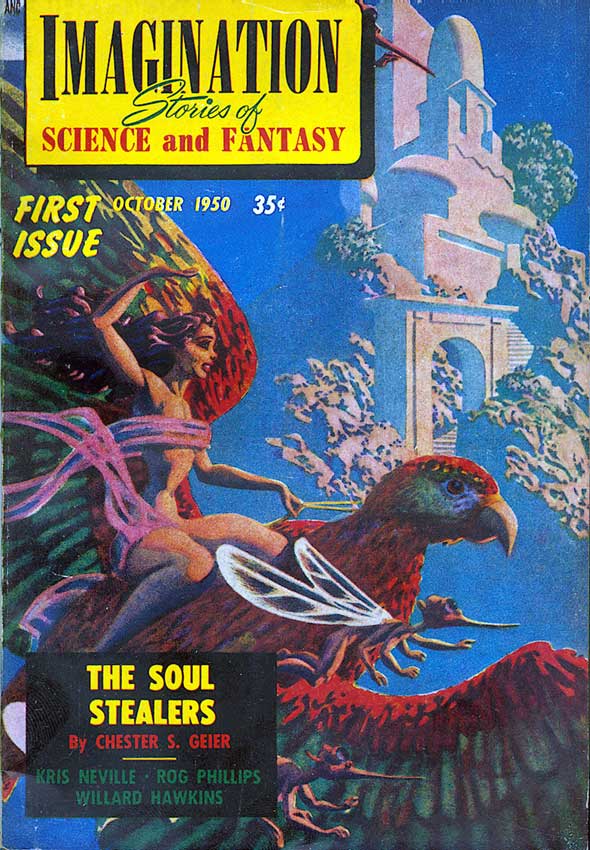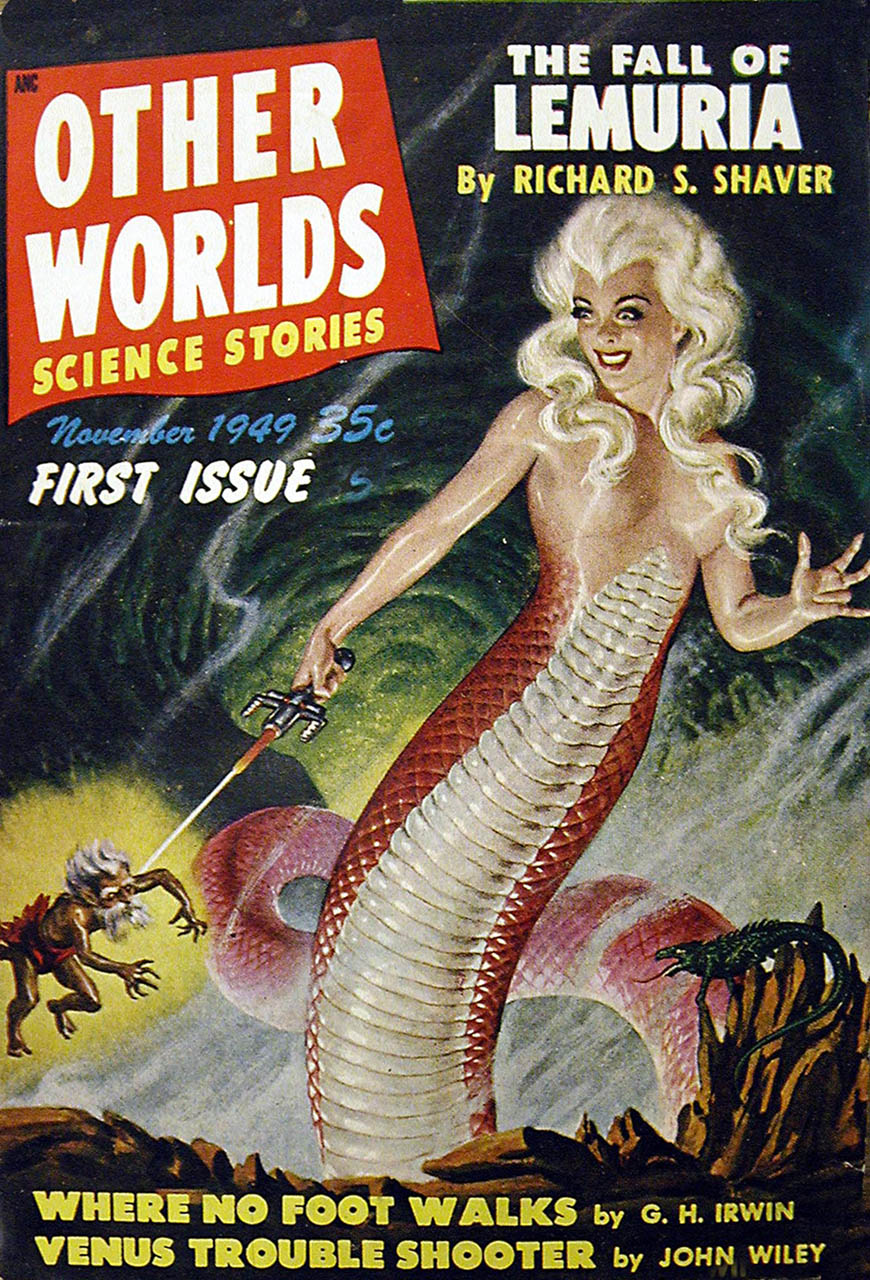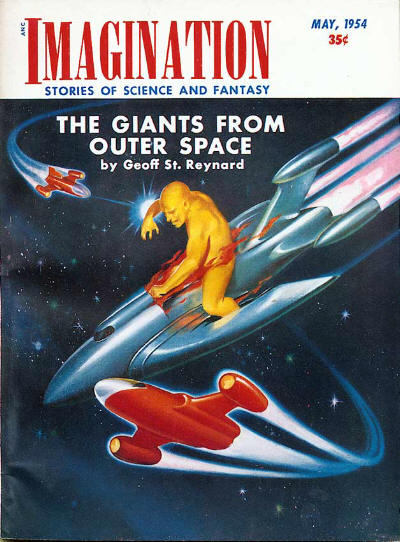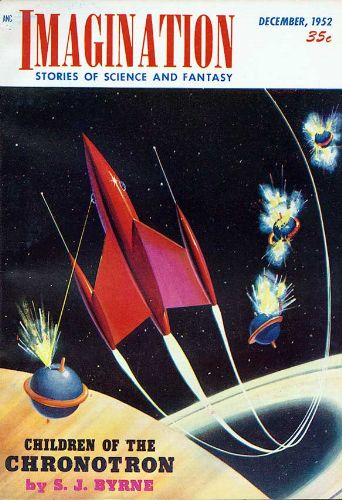Imagination (magazine) on:
[Wikipedia]
[Google]
[Amazon]
 ''Imagination'' was an American
''Imagination'' was an American
 American science fiction magazines first appeared in the 1920s with the appearance of ''
American science fiction magazines first appeared in the 1920s with the appearance of ''
 The cover story for the first issue was "The Soul Stealers" by Chester S. Geier, a regular in the Ziff-Davis magazines ''
The cover story for the first issue was "The Soul Stealers" by Chester S. Geier, a regular in the Ziff-Davis magazines ''
 ''Imagination'' was
''Imagination'' was
''Imagination'' Magazine
on the
 ''Imagination'' was an American
''Imagination'' was an American fantasy
Fantasy is a genre of speculative fiction involving magical elements, typically set in a fictional universe and sometimes inspired by mythology and folklore. Its roots are in oral traditions, which then became fantasy literature and d ...
and science fiction magazine
A science fiction magazine is a publication that offers primarily science fiction, either in a hard-copy periodical format or on the Internet.
Science fiction magazines traditionally featured speculative fiction in short story, novelette, nove ...
first published in October 1950 by Raymond Palmer's Clark Publishing Company. The magazine was sold almost immediately to Greenleaf Publishing Company, owned by William Hamling, who published and edited it from the third issue, February 1951, for the rest of the magazine's life. Hamling launched a sister magazine, ''Imaginative Tales'', in 1954; both ceased publication at the end of 1958 in the aftermath of major changes in US magazine distribution due to the liquidation of American News Company.
The magazine was more successful than most of the numerous science fiction titles launched in the late 1940s and early 1950s, lasting a total of 63 issues. Despite this success, the magazine had a reputation for low-quality space opera and adventure fiction, and modern literary historians refer to it in dismissive terms. Hamling consciously adopted an editorial policy oriented toward entertainment, asserting in an early issue that "science fiction was never meant to be an educational ''tour de force''".Hamling, "The Editorial", in ''Imagination'', November 1951, pp. 146–147. Few of the stories from ''Imagination'' have received recognition, but it did publish Robert Sheckley
Robert Sheckley (July 16, 1928 – December 9, 2005) was an American writer. First published in the science-fiction magazines of the 1950s, his many quick-witted stories and novels were famously unpredictable, absurdist, and broadly comical.
...
's first professional sale, "Final Examination", in the May 1952 issue, and also printed fiction by Philip K. Dick, Robert A. Heinlein
Robert Anson Heinlein (; July 7, 1907 – May 8, 1988) was an American science fiction author, aeronautical engineer, and naval officer. Sometimes called the "dean of science fiction writers", he was among the first to emphasize scientific accu ...
and John Wyndham
John Wyndham Parkes Lucas Beynon Harris (; 10 July 1903 – 11 March 1969) was an English science fiction writer best known for his works published under the pen name John Wyndham, although he also used other combinations of his names ...
.
History
 American science fiction magazines first appeared in the 1920s with the appearance of ''
American science fiction magazines first appeared in the 1920s with the appearance of ''Amazing Stories
''Amazing Stories'' is an American science fiction magazine launched in April 1926 by Hugo Gernsback's Experimenter Publishing. It was the first magazine devoted solely to science fiction. Science fiction stories had made regular appearances ...
'', a pulp magazine published by Hugo Gernsback
Hugo Gernsback (; born Hugo Gernsbacher, August 16, 1884 – August 19, 1967) was a Luxembourgish–American editor and magazine publisher, whose publications including the first science fiction magazine. His contributions to the genre as pub ...
. The beginnings of science fiction as a separately marketed genre can be traced to this time, and by the end of the 1930s the field was undergoing its first boom, but World War II
World War II or the Second World War, often abbreviated as WWII or WW2, was a world war that lasted from 1939 to 1945. It involved the vast majority of the world's countries—including all of the great powers—forming two opposing ...
and its attendant paper shortages led to the demise of several titles. By the late 1940s the market began to recover again. From a low of eight active magazines in 1946, the field expanded to 20 in 1950, and a further 22 had commenced publication by 1954.Magazine publishing dates for the period are tabulated in Ashley, ''History of the Science Fiction Magazine Vol. 3'', pp. 323–325. ''Imagination'' was launched in the middle of this publishing boom.
The groundwork was laid in 1947, when Clark Publishing, the company that would publish the first issue of ''Imagination'', was incorporated in Evanston, Illinois
Evanston ( ) is a city, suburb of Chicago. Located in Cook County, Illinois, United States, it is situated on the North Shore along Lake Michigan. Evanston is north of Downtown Chicago, bordered by Chicago to the south, Skokie to the west, ...
, by Raymond Palmer. He worked for Ziff-Davis
Ziff Davis, Inc. is an American digital media and internet company. First founded in 1927 by William Bernard Ziff Sr. and Bernard George Davis, the company primarily owns technology-oriented media websites, online shopping-related services, an ...
as the editor of ''Amazing Stories
''Amazing Stories'' is an American science fiction magazine launched in April 1926 by Hugo Gernsback's Experimenter Publishing. It was the first magazine devoted solely to science fiction. Science fiction stories had made regular appearances ...
'' and did not leave until the end of 1949, but he launched two magazines under the Clark name before that date: '' Fate'', in the spring of 1948, and '' Other Worlds'', the first issue of which was dated November 1949.Mike Ashley, ''Transformations'', pp. 7–10. Both of these magazines listed their editor as "Robert N. Webster", a pseudonym Palmer adopted while he was still at Ziff-Davis because of the conflict of interest. The second issue of ''Other Worlds'' reported that Webster and Palmer were going to edit together; by the third issue, dated March 1950, the pretense had been dropped and although there was no masthead listing the editor, the editorial was simply signed "Rap" (for "Raymond A. Palmer"). At the 1949 World Science Fiction Convention in Cincinnati
Cincinnati ( ) is a city in the U.S. state of Ohio and the county seat of Hamilton County. Settled in 1788, the city is located at the northern side of the confluence of the Licking and Ohio rivers, the latter of which marks the state line wit ...
, held over the weekend of 3–5 September, Palmer announced that he had left Ziff-Davis and described his plans for Clark Publishing. He also met and hired Bea Mahaffey, a 21-year-old science fiction fan attending her first convention, as his assistant editor.Ashley, ''History of SF Magazine Vol. 3'', pp. 45–46.See the individual issues of ''Other Worlds''. An online index is available at
With ''Fate'' and ''Other Worlds'' launched, Palmer began to plan for a new magazine, to be called ''Imagination''. Material for the first two issues had been assembled by mid-1950, but in the early summer Palmer fell down his basement stairs and was left paralyzed from the waist down. While he was hospitalized, much of the work of editing both ''Other Worlds'' and ''Imagination'' was done by Mahaffey, who coped well, despite her inexperience. An assistant, Marge Budwig Saunder, was hired to read the slush pile
In publishing, a slush pile is a set of unsolicited query letters or manuscripts that have either been directly sent to a publisher by an author, or which have been delivered via a literary agent representing the author who may or may not be f ...
and help out. The magazine's first issue, dated October 1950 on a planned bi-monthly schedule, appeared on news stands 1 August 1950. However, in September that year, Ziff-Davis made the decision to move to New York from Chicago; Palmer promptly contacted William Hamling, who did not want to relocate and suggested that Hamling take over ''Imagination''. Like Palmer, Hamling had made preparations to leave Ziff-Davis by establishing a separate publishing company, Greenleaf Publishing, and in November 1950 Hamling left Ziff-Davis and became ''Imaginations editor and publisher.Ashley, ''History of SF Magazine Vol. 3'', pp. 48–49.
In 1954 Hamling started a companion magazine, '' Imaginative Tales''; in addition, his company Greenleaf Publishing was the publisher of '' Rogue'', a men's magazine modelled after ''Playboy
''Playboy'' is an American men's Lifestyle magazine, lifestyle and entertainment magazine, formerly in print and currently online. It was founded in Chicago in 1953, by Hugh Hefner and his associates, and funded in part by a $1,000 loan from H ...
''. In 1957 the liquidation of American News Company, a major distributor, meant that many magazines had to scramble to find new distributors. Independent distributors often required that the magazines be monthly, and that they be in a larger format than the digest-size common in science fiction magazines. The larger format required higher revenue to be profitable, but in many cases it proved impossible to attract the additional advertising income that would have kept the magazines afloat. By the end of 1958, many titles had disappeared as a result, with ''Imagination'' one of the victims; Hamling closed down both ''Imagination'' and its sister magazine to invest the money in ''Rogue'' instead. The last issue of ''Imagination'' was October 1958, the 63rd issue, while ''Imaginative Tales'', retitled ''Space Travel'', ceased with the November 1958 issue.Michael Ashley, ''Transformations'', pp. 190–193. There was no indication in either magazine that the end had come, though the last issue of ''Imagination'' omitted its letter, book review and pen-pal columns, all of which had appeared regularly in prior issues.See the individual issues. Online indices are available at and
Circulation figures were not required to be published annually until the 1960s,See for example the statement of circulation in "Statement Required by the Act of October 23, 1962", ''Analog Science Fiction/Science Fact'' vol. 76, no 4 (December 1965), p.161. so the actual circulation figures are not known. For comparison, the more successful '' Magazine of Fantasy and Science Fiction'', which had been launched the previous year, is known to have had a circulation of just under 60,000 copies for its first issue, dated Fall 1949.Mike Ashley, ''Transformations'', p. 22.
Contents and reception
 The cover story for the first issue was "The Soul Stealers" by Chester S. Geier, a regular in the Ziff-Davis magazines ''
The cover story for the first issue was "The Soul Stealers" by Chester S. Geier, a regular in the Ziff-Davis magazines ''Amazing Stories
''Amazing Stories'' is an American science fiction magazine launched in April 1926 by Hugo Gernsback's Experimenter Publishing. It was the first magazine devoted solely to science fiction. Science fiction stories had made regular appearances ...
'' and '' Fantastic Adventures''. The story was a science fantasy tale of Leeta, a beautiful woman from another dimension stealing the souls of men to try to save her father. The cover illustration, by Hannes Bok, showed Leeta on her flying steed. Other contributors included Rog Phillips, another prolific magazine author, and Kris Neville, whose first story had been published only the year before. Neville's work appeared regularly in the first few years of the magazine; other prolific contributors included Dwight V. Swain, Daniel F. Galouye and Milton Lesser. Edmond Hamilton
Edmond Moore Hamilton (October 21, 1904 – February 1, 1977) was an American writer of science fiction during the mid-twentieth century.
Early life
Born in Youngstown, Ohio, he was raised there and in nearby New Castle, Pennsylvania. So ...
's work also appeared frequently towards the end of the magazine's life.Stableford, "Imagination", in Nicholls & Clute, ''Encyclopedia of Science Fiction'', p. 615. The magazine often contained a long novel as the lead attraction.Donald H. Tuck, ''Encyclopedia of SF'', pp. 570–571.
In addition to less well-known regulars, some more prominent writers occasionally appeared. Ray Bradbury
Ray Douglas Bradbury (; August 22, 1920June 5, 2012) was an American author and screenwriter. One of the most celebrated 20th-century American writers, he worked in a variety of modes, including fantasy, science fiction, horror, mystery fictio ...
's "The Fire Balloons" was published in the April 1951 issue, under the title "'…In This Sign'"; the story was later incorporated into Bradbury's fixup
A fix-up (or fixup) is a novel created from several short fiction stories that may or may not have been initially related or previously published. The stories may be edited for consistency, and sometimes new connecting material, such as a frame s ...
s, ''The Martian Chronicles
''The Martian Chronicles'' is a science fiction fix-up novel, published in 1950, by American writer Ray Bradbury that chronicles the exploration and settlement of Mars, the home of indigenous Martians, by Americans leaving a troubled Earth th ...
'' and ''The Illustrated Man
''The Illustrated Man'' is a 1951 collection of 18 science fiction short stories by American writer Ray Bradbury. A recurring theme throughout the stories is the conflict of the cold mechanics of technology and the psychology of people. It was ...
''. Robert Sheckley
Robert Sheckley (July 16, 1928 – December 9, 2005) was an American writer. First published in the science-fiction magazines of the 1950s, his many quick-witted stories and novels were famously unpredictable, absurdist, and broadly comical.
...
's first story, "Final Examination", appeared in the May 1952 issue. Other well-known authors who were published in ''Imagination'' include Poul Anderson
Poul William Anderson (November 25, 1926 – July 31, 2001) was an American fantasy and science fiction author who was active from the 1940s until the 21st century. Anderson wrote also historical novels. His awards include seven Hugo Awards and ...
, John Wyndham (as "John Beynon"), James Blish
James Benjamin Blish () was an American science fiction and fantasy writer. He is best known for his '' Cities in Flight'' novels and his series of ''Star Trek'' novelizations written with his wife, J. A. Lawrence. His novel '' A Case of Conscie ...
, Philip K. Dick, Harlan Ellison, Robert A. Heinlein, Frederik Pohl and Robert Silverberg
Robert Silverberg (born January 15, 1935) is an American author and editor, best known for writing science fiction. He is a multiple winner of both Hugo and Nebula Awards, a member of the Science Fiction and Fantasy Hall of Fame, and a Gr ...
.
''Imagination'' is generally thought of by historians of science fiction as one of the weaker magazines of the 1950s, despite its relative longevity. Donald Tuck
Donald Henry Tuck (3 December 1922 – 11 October 2010) was an Australian bibliographer of science fiction, fantasy and weird fiction. His works were "among the most extensive produced since the pioneering work of Everett F. Bleiler."
, in his ''Encyclopedia of Science Fiction and Fantasy'', dismissed the novels it published, saying, "not many were noteworthy, most being in the interplanetary/space opera/adventure field", and Brian Stableford
Brian Michael Stableford (born 25 July 1948) is a British academic, critic and science fiction writer who has published more than 70 novels. His earlier books were published under the name Brian M. Stableford, but more recent ones have dropped ...
, a science fiction writer and critic, described it as dealing "primarily in routine space opera." James Blish
James Benjamin Blish () was an American science fiction and fantasy writer. He is best known for his '' Cities in Flight'' novels and his series of ''Star Trek'' novelizations written with his wife, J. A. Lawrence. His novel '' A Case of Conscie ...
, writing under the pseudonym "William Atheling, Jr.", which he used for some of his critical writing, remarked that it was a "widely unread" magazine.Atheling, ''More Issues at Hand'', p. 38. Hamling's editorial policy was consciously slanted against intellectualism. In the November 1951 issue he commented that "science fiction was never meant to be an educational ''tour de force''. The so-called ''adult'' story is nothing more than an attempt to show the reader how dumb he is and how smart the editor is." ''Imaginations approach, he said, was to publish entertainment: "What we need is a little relaxation. And entertaining reading is one way to get it." Some readers agreed with Hamling; a 1952 issue of ''Rhodomagnetic Digest'', a fanzine, contains approving commentary on Hamling's editorial by Gregg Calkins, a fan of the period.
Starting with the April 1951 issue, a regular column on science fiction fandom began, titled "Fandora's Box". It was written by Mari Wolf, an active fan, for five years, and was taken over by Robert Bloch from June 1956 through the end. The column had an excellent reputation, and was one of the few such columns in the American science fiction professional magazines. Every issue carried an editorial, and a letter column appeared in every issue but the very last. A book review column began in June 1953, and appeared in every issue except the last one. It was initially by Mark Reinsberg, and was taken over by Henry Bott in May 1954 after two months in which both reviewers contributed to the column. A "Cosmic Pen Club" column, where fans could post requests for pen-pals, began in February 1957; as with the book reviews it appeared regularly, excepting only the last issue. Beginning in September 1951, the inside front cover was often used for an "Introducing the Author" feature, with short pieces by and about a writer or artist who appeared in the issue. These included photographs of the authors in question, a feature not typically found in other magazines. Among the authors featured were Heinlein, Evan Hunter and Philip K. Dick. "Introducing the Author" skipped four issues from October 1954 to January 1955, and ceased altogether with the April 1956 issue. One issue, May 1953, included pictures from that year's World Science Fiction in Chicago, rather than a feature about an author. The most frequently appearing cover artists were Harold W. McCauley, Lloyd Rognan, Malcolm Smith and William Terry.
Bibliographic details
 ''Imagination'' was
''Imagination'' was digest size
Digest size is a magazine size, smaller than a conventional or "journal size" magazine but larger than a standard paperback book, approximately , but can also be and , similar to the size of a DVD case. These sizes have evolved from the printing ...
(7.5 × 5.5 inches (19.1 × 14.0 cm)) for its first 17 issues, and then shrank slightly to a short digest size (7.25 × 5.5 inches or 18.4 × 14.0 cm) for the rest of its run, a further 46 issues. The volume number rose by one at the start of each calendar year, regardless of the number of issues. Volume 1, 1950, contained only two issues; subsequent volumes contained five to twelve issues, depending on frequency of publication. The overall issue number was printed on the spine (an unusual practice) along with the volume number. The first issue had a publication date of October 1950, and the schedule was bimonthly through the September 1952 issue except that June 1951 was followed by September 1951. The next four issues were dated October 1952, December 1952, January 1953 and February 1953, and then a monthly run began with April 1953 that lasted without a break until the July 1955 issue. The next issue was October 1955, which inaugurated another bimonthly period that ran with perfect regularity until the last issue, October 1958. The price remained at 35 cents throughout.
The title of the magazine was initially "Imagination: Stories of Science and Fantasy"; it changed with the October 1955 issue to "Imagination: Science Fiction", though this change was only on the cover and spine and was never reflected on the masthead.
The first 28 issues were 166 pages long. The page count dropped to 134 with the April 1954 issue and stayed at that length for the remainder of the run. The cover layout initially strongly resembled that of ''Other Worlds'' but was changed with the fifth issue, June 1951, to have a white background banner for the title. This format was retained for the rest of the magazine's life, with occasional slight variations such as using a different color for the banner background. The spine also changed from a colored spine with pale lettering, which was similar to the spine style used by ''Other Worlds'', to a white spine with red or blue lettering.
The publisher was Clark Publishing Company for the first two issues. The editor for those issues was Raymond Palmer, but as he was hospitalized much of the work was done by Bea Mahaffey. As a result, these two issues are sometimes indexed with Mahaffey as editor.Ashley lists Mahaffey as the editor of the first two issues in the appendices to ''Transformations'', p. 329, though in his earlier ''History of the Science Fiction Magazine, Vol. 3'' he lists Palmer as editor. Tuck and Stableford (1993) (p. 615) both list Palmer rather than Mahaffey. With the third issue, Greenleaf Publishing Company became the publisher and William Hamling took over as editor, a position he retained throughout the magazine's life.
References
Sources
* * * * * Malcolm Edwards and Peter Nicholls, "Astounding Science-Fiction", in * Malcolm Edwards and Peter Nicholls, "SF Magazines", in * Brian Stableford, "Imagination", in * * Peter Nicholls and John Clute, "Genre SF", in * Brian Stableford, "Amazing Stories", in *External links
{{Commons category''Imagination'' Magazine
on the
Internet Speculative Fiction Database
The Internet Speculative Fiction Database (ISFDB) is a database of bibliographic information on genres considered speculative fiction, including science fiction and related genres such as fantasy, alternate history, and horror fiction. The ISFDB ...
1950 establishments in the United States
1958 disestablishments in the United States
Bimonthly magazines published in the United States
Defunct science fiction magazines published in the United States
Magazines disestablished in 1958
Magazines established in 1950
Monthly magazines published in the United States
Science fiction magazines established in the 1950s